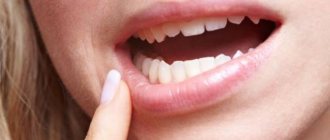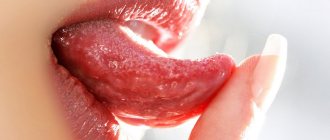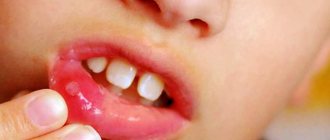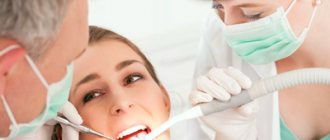The formation of wounds in the oral cavity, or more precisely, on the surface of the palate, can be caused by a number of infectious diseases, and not only. The most common reasons include the development of any infectious diseases, as well as stress, leading to a decrease in the protective functions of the body.
Palpation of inflamed areas of the mucous membrane can be accompanied by acute pain, and the affected areas themselves can complicate the process of chewing and swallowing food, as well as speech function.
Symptoms
Ulcers, or in scientific terms aphthae, cause a lot of inconvenience, so they cannot be asymptomatic and a person will immediately understand that the mucous membrane of the palate is not in order:
- Due to the appearance of ulcers, the mucosal tissues swell, and this can make speech difficult.
- It is impossible to eat hot, spicy, sour and salty foods, as they will irritate the damaged surface of the palate.
- A person, even with his mouth closed at rest, may experience pain, and in advanced cases, the ulcers bleed.
Not all canker sores are harmless.
Of course, if they were formed due to mechanical damage to the mucous membrane, they will go away on their own in the shortest possible time. If the ulcers do not go away, you need to track the accompanying symptoms in time to begin treating systemic diseases:
- When the herpes virus enters the oral mucosa , a person’s condition generally worsens, body temperature may rise, lymph nodes enlarge, salivation increases, and then small wounds form on the palate.
- Often, with a decrease in immunity or long-term use of antibiotics, it is possible to develop a disease such as candidiasis or thrush of the oral mucosa. In this case, a burning sensation is felt, taste sensations are lost, and a characteristic white coating of a cheesy appearance forms on the entire mucous membrane; eventually, aphthae can form on the palate, which sometimes bleed.
- When infected with syphilis at the beginning in the oral cavity , a rash may occur, which then develops into ulcers on the soft tissue of the palate and cheeks.
- Aphthous stomatitis. A chronic disease characterized by inflammation of the oral mucosa and the appearance of ulcers on the palate. Besides. such stomatitis can be a symptom of generalized aphthosis, a disease that affects all mucous tissues in humans (gastrointestinal tract, genitals, eyes). Ulcers form gray-yellow in size from 2 to 10 mm, depending on the course and stage of the disease. They are quite deep, painful, do not heal for a long time and often recur.
- With pulmonary tuberculosis , initially small compactions in the form of reddened tubercles may form on the palate, which then transform into shallow round wounds.
Signs of disease development
The main sign of the formation of stomatitis is an ulcer on the palate, covered with a yellowish coating in the form of a film and having a round shape. This phenomenon causes severe burning and pain while eating, as well as from touching the affected area. As the disease progresses, mouth ulcers increase in size. In addition, the number of these formations is growing.
As the pathology progresses, additional unpleasant sensations arise:
- a metallic taste appears in the mouth;
- the patient loses taste;
- the palate area swells and has a bright red color;
- hemorrhage forms on the mucous membrane;
- severe itching occurs.
In mild cases, the problem goes away on its own within two weeks. However, in severe cases, an integrated approach will be required, starting from eliminating the root cause and consequences.
Diagnostics
If aphthae occurs on the roof of your mouth, you should contact your dentist.
The doctor will examine the oral mucosa and may ask the following clarifying questions:
- How long ago did the ulcers appear?
- How painful are they?
- Do they bleed?
- Does the patient smoke or not?
- What are the common chronic diseases, and what diseases were recently suffered?
- Do any of your relatives have similar ulcers?
Your doctor may order a blood test and, in extreme cases, a biopsy. If the dentist believes that aphthae appeared as a result of some disease that is not within his competence, he will refer you to the appropriate specialist. Otherwise, he prescribes treatment himself.
How to get rid of an old encapsulated wound on the mucous membrane
An encapsulated wound on the oral mucosa indicates that the pathological process is ancient. If after 3-4 weeks of intensive therapy no positive dynamics are observed, the question of radical treatment is raised.
Old, non-healing wounds are treated with a minor operation performed by a surgeon. After removing the capsule, antimicrobial ointments are prescribed. They speed up recovery and prevent the development of complications.
Timely seeking medical help, early diagnosis of the cause of the pathology, and compliance with medical recommendations will help prevent the formation of an old lesion in the mouth.
Treatment
If wounds on the palate appear as a result of mechanical damage, then no special measures should be taken.
The only thing is to eliminate the cause of their formation, that is, avoid foods with sharp edges, brush your teeth more carefully, take a break from eating sour, salty and hot foods. The epithelial tissues will renew themselves, and the palate will return to normal.
You can rinse your mouth with a collection of medicinal herbs such as chamomile, sage, calendula.
Treatment of aphthae caused by some diseases of the body must be carried out in three directions:
- Eliminating the cause of ulcers.
- Local treatment of ulcers, their permanent treatment.
- Relieving pain.
To eliminate the causes, you must first increase your overall immunity.
The doctor may prescribe general health-improving medications and vitamin-mineral complexes. To eliminate swelling, antihistamines are prescribed at the discretion of the specialist. If the wounds cause severe discomfort, painkillers containing paracetamol or ibuprofen are used.
In case of acute pain, before contacting a specialist, it is possible to use lidocaine in a spray. If the cause of aphthae on the palate is a disease such as candidiasis, the doctor will prescribe antifungal drugs, for example, Diflucan or Flucostat.
If the cause lies in herpes, antiviral drugs are used, for example, Zovirax or Acyclovir.
Ulcers caused by bacterial infections require more serious treatment with antibiotics of various groups.
Aphthae that appear against the background of tuberculosis, syphilis and other infections are treated with appropriate anti-tuberculosis, anti-syphilitic and antiviral drugs.
For local treatment of ulcers, doctors usually prescribe rinsing with antiseptic solutions (for example, chlorhexidine solution or miramistin). Rinsing with pharmaceutical herbs has also proven to work well. Levomekol can be used as an ointment.
Why does inflammation occur?
The muscular structure of the palate is covered on top with a mucous membrane, which is subject to the development of an inflammatory process. Inflammation often occurs under the influence of such factors:
- burn of the mucous membrane as a result of consuming excessively hot food and drinks;
- damage to the palate due to dental diseases - periodontitis, stomatitis, caries, pulpitis;
- disruption of the oral environment due to the action of metals - when wearing braces or installing crowns;
- smoking;
- allergic reactions to medications;
- neurological diseases affecting the joints of the upper or lower jaw;
- osteomyelitis - an infectious lesion of the bone tissue of the jaw;
- malignant neoplasms;
- infectious diseases of the upper respiratory tract - sore throat, tonsillitis, pharyngitis, rhinitis.
The development of the inflammatory process of the palate may be facilitated by some of these causes in their entirety or separately from each other.
Folk remedies for the treatment of ulcers on the palate
For rinsing, you can use thyme herb, brewed in boiling water, waiting until it cools to room temperature.
There are many traditional medicines that can relieve pain from wounds on the palate or help relieve inflammation:
- Dilute 1 teaspoon of salt and 1 teaspoon of soda in a glass of boiled warm water. Rinse your mouth with this solution 3 times a day.
- Dilute 2 teaspoons of calendula tincture in a glass of boiled water, rinse 2 times a day.
- Use freshly squeezed carrot juice diluted with water for rinsing 3-4 times a day.
- Grate raw potatoes on a fine grater and use the resulting pulp as a lotion for canker sores.
- Many people find that smearing ulcers with honey helps.
- One of the folk recipes suggests using the following option: you need to mix half a glass of milk with 1 egg yolk and a spoonful of honey. Mix the mixture well until smooth, then wrap your finger in a clean sterile cloth or bandage, dip it in the mixture and wipe the wounds. It is enough to wipe 3-4 times a day for 3 days.
It should be remembered that you should not get too carried away with folk remedies. With their help, you can relieve symptoms, relieve minor inflammation, or help the mucous membrane regenerate faster. The search for and treatment of the main cause of ulcers on the palate should be carried out by a specialist.
Self-therapy
Most often, treatment of ulcers on the palate is associated with stomatitis. In this case, you can do without medical help and carry out the therapy yourself. The following methods are used for this.
1. Rinse the mouth with Furacilin solution. To do this, you need to dissolve 4 tablets of the drug in a glass of boiling water. After the liquid has cooled to an acceptable temperature, rinse your mouth thoroughly.
2. Cauterization of ulcers with Furacilin or Chlorhexidine. You need to crush the drug tablet into gauze and apply it to the affected area for 5-10 minutes.
3. Cauterization with iodine or brilliant green is just as effective, but painful compared to other methods.
4. Applying healing ointments, such as Metrogyl Denta, which are intended for ulcers and damage to the oral mucosa.
Most often, when using these remedies at the beginning of the disease, ulcers can be eliminated within a few days.
Drug treatment
It should be noted here: the prescription of medications to eliminate ulcers in the oral cavity should be carried out exclusively by a dentist.
Since only a professional doctor is able to determine the exact etiology of the disease and, based on this, prescribe the necessary medications.
We propose to briefly familiarize yourself with some drugs and means that can eliminate both the disease itself and its consequences.
- Antibiotics. Most often, this class of medications is prescribed when the disease is severe. The duration of treatment and the type of such medications are selected strictly individually.
- Two percent gel Xikain. Reduces painful manifestations and successfully fights pathogenic and inflammatory microbes, which helps wounds and ulcers heal in the shortest possible time. The use of Xikain gel is strictly contraindicated for children under six years of age. The reason for this is the presence of components harmful to the child’s body in this medication.
- Medicinal ointments. A very well proven remedy is Benzocaine ointment. Having an anti-inflammatory effect, this ointment can quickly eliminate inflammation in the mouth. This product contains analgesic components, so it is recommended to use it in the presence of pronounced pain.
- Benzocaine can cause an allergic reaction, so it is not recommended for children to treat ulcers. For them, you can use, for example, an ointment like Kamistad.
- Analgesic injections. The only really significant advantage of this type of drugs over others is the speed of action on the affected areas of the oral cavity, which makes it possible to urgently eliminate pain syndromes, especially with open ulcers, when the pain is felt most acutely. However, injections are completely ineffective in eliminating the causes that provoked the appearance of wounds inside the oral cavity.
This is interesting: Why can there be a sour taste in the mouth and what does this mean?
Diet food
Sometimes mouth ulcers can appear due to poor diet. Most often, this is experienced by children who abuse junk food and carbonated drinks. To eliminate ulcers that are a consequence of such a diet, it is necessary to include the following products in the diet:
- vegetables, especially those rich in fiber;
- fruits rich in vitamins;
- dietary meat - chicken, rabbit, lean beef;
- berries;
- legumes;
- greenery;
- cereals – buckwheat, oatmeal, barley;
- offal – chicken liver, hearts, ventricles;
- low-fat fish.
By restoring proper nutrition, you can avoid the recurrence of ulcers and speed up the healing of existing ones.
Oral hygiene
Sometimes stomatitis is called the disease of dirty hands, due to the fact that the bacteria present on them, getting into wounds in the mouth, can cause ulcers. Therefore, dentists recommend adhering to the following hygiene rules:
- do not allow the child to put all sorts of different objects from the floor, as well as his own fingers, into his mouth;
- use toothpastes without sodium lauryl sulfate;
- it is necessary to choose a toothbrush that matches the sensitivity of the gums, since too hard bristles can injure the delicate mucous membrane of the mouth;
- You should avoid excessive use of antiseptic rinses, as they wash away the natural protective layer.
Also, from childhood, it is necessary to accustom your child to the fact that it is necessary to brush his teeth twice a day - in the morning and in the evening.
Prevention
What to do and what not to do:
- It is necessary to strictly observe oral hygiene.
- Visit the dentist 2 times a year.
- It is advisable to minimize sour, spicy, salty foods in your diet, and try not to eat too hot food, which can burn the mucous membrane of the palate.
- It is necessary to determine whether there are any allergies to any food products, because they can cause ulcers to appear on the palate.
- It is recommended to take vitamin complexes, and also monitor the level of iron, zinc and folic acid in the body, because their lack provokes aphthae.
- Doctors also recommend strengthening the immune system and avoiding emotional stress.
If you follow preventive measures and start treatment at an early stage, you can avoid such troubles as ulcers on the palate.
Functions of the sky and structural features
The palate is a vault that separates the oral cavity from the nasopharynx. The structure of the palate consists of two sections - hard and soft. This organ performs an important function - it prevents food from entering the nasopharynx from the oral cavity.
In addition, receptors on the surface of the palate are associated with the larynx and take part in articulation and influence the timbre of the voice and the pitch of sounds. Thus, the inflammatory process of the upper palate disrupts all the functions of this important organ, and therefore requires mandatory treatment.










